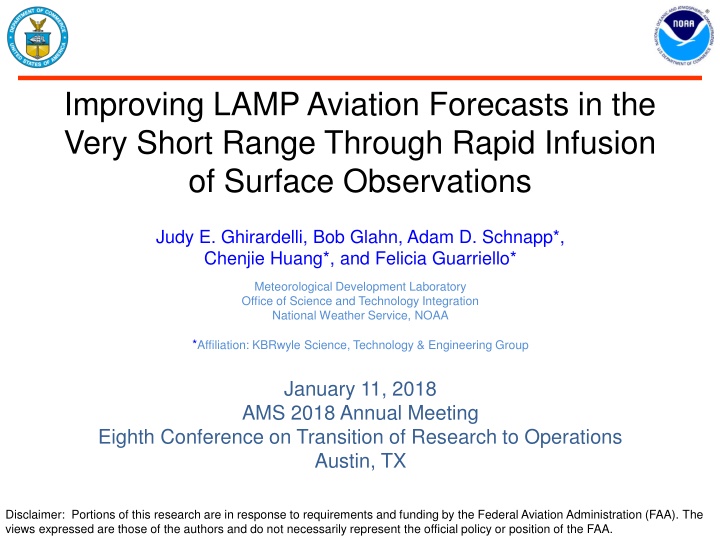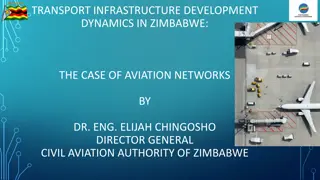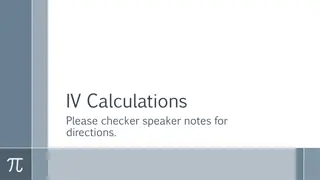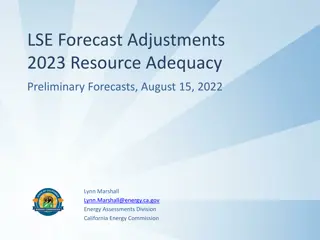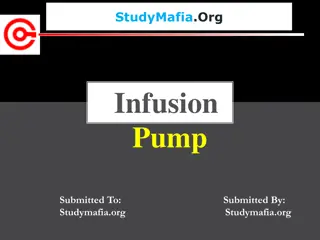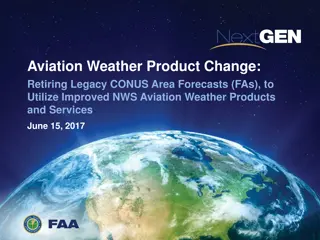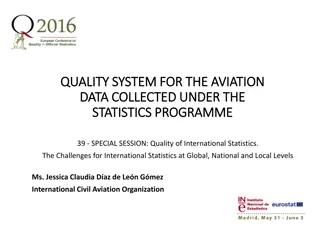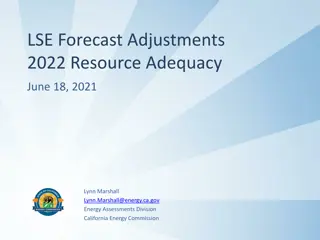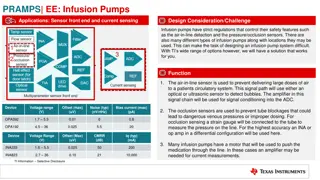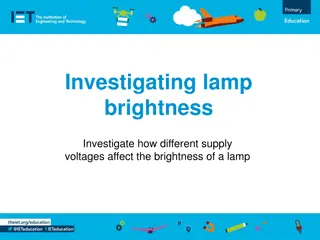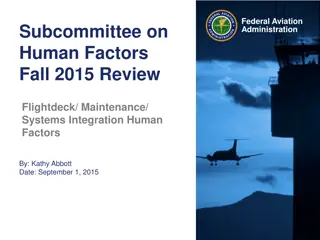Improving LAMP Aviation Forecasts through Rapid Infusion of Surface Observations
This research explores enhancing aviation forecasts in the very short range by incorporating surface observations into the Localized Aviation MOS Program (LAMP). LAMP combines observations, model output, and MOS guidance to bridge the gap between observations and model forecasts, providing hourly guidance for a short-range period. The study emphasizes the significance of observations in predicting weather phenomena.
Download Presentation

Please find below an Image/Link to download the presentation.
The content on the website is provided AS IS for your information and personal use only. It may not be sold, licensed, or shared on other websites without obtaining consent from the author.If you encounter any issues during the download, it is possible that the publisher has removed the file from their server.
You are allowed to download the files provided on this website for personal or commercial use, subject to the condition that they are used lawfully. All files are the property of their respective owners.
The content on the website is provided AS IS for your information and personal use only. It may not be sold, licensed, or shared on other websites without obtaining consent from the author.
E N D
Presentation Transcript
Improving LAMP Aviation Forecasts in the Very Short Range Through Rapid Infusion of Surface Observations Judy E. Ghirardelli, Bob Glahn, Adam D. Schnapp*, Chenjie Huang*, and Felicia Guarriello* Meteorological Development Laboratory Office of Science and Technology Integration National Weather Service, NOAA *Affiliation: KBRwyle Science, Technology & Engineering Group January 11, 2018 AMS 2018 Annual Meeting Eighth Conference on Transition of Research to Operations Austin, TX Disclaimer: Portions of this research are in response to requirements and funding by the Federal Aviation Administration (FAA). The views expressed are those of the authors and do not necessarily represent the official policy or position of the FAA.
Alternative title: The Power of the Obs Obs 2
Outline 1. LAMP Background 2. The power of the observations in: LAMP s convection and lightning guidance LAMP s 15-minute updates for ceiling and visibility guidance 3. Research to Operations Considerations 3
Localized Aviation MOS Program (LAMP): Background LAMP is a statistical system that uses observations, MOS output, and model output to provide guidance for aviation forecasting LAMP bridges the gap between the observations and the model forecasts LAMP guidance is produced hourly and covers the short-range period of 1- 25 hours (soon to be 36 hours) The most important predictors in the very short-range are: Observations 4
Localized Aviation MOS Program (LAMP): Background LAMP provides station-oriented guidance for: all LAMP forecast elements, ~2000 stations CONUS, Alaska, Hawaii, Puerto Rico Temperature and dewpoint Wind speed, direction, and gusts Probability of precipitation (on hr) Probability of measurable precipitation (6- and 12-h) Precipitation type Precipitation characteristics Lightning/Convection Ceiling height Conditional ceiling height Opaque sky cover Visibility Conditional visibility Obstruction to vision Gridded LAMP provides grid-oriented guidance for: Lightning Convection Temperature Dewpoint Ceiling Height Visibility Sky Cover Wind Speed, Direction, Gusts Ceiling and Visibility Probability grids 5
LAMP Convection and Lightning Guidance 6
LAMP Convection and Lightning Guidance Definitions: Convection event: radar reflectivity 40 dBZ and/or 1 lightning flashes Lightning event: 1 lightning flashes Predictands based on: Multi-Radar Multi-Sensor (MRMS) composite reflectivity Total Lightning (TL; cloud-to-ground and in-cloud flashes from Earth Networks Total Lightning Network) Predictors based on: MRMS data Total Lightning data High Resolution Rapid Refresh (HRRR) model data Global Forecast System (GFS) and North American Mesoscale (NAM) MOS 7
Convection and Lightning Example Data January 04, 2018 (East Coast Snow Storm) MRMS1 reflectivity 01/04/2018 1200 UTC 1MRMS reflectivity remapped to 5-km 8
Convection and Lightning Example Data January 04, 2018 (East Coast Snow Storm) Total Lightning Flashes for the day 01/04/2018 9
LAMP 1-hr Convection Development: The importance of the predictors 60 LAMP using initial observations only 55 50 45 Init Obs only 40 Brier Skill Score (%) 35 30 25 20 15 10 5 0 1 2 3 4 5 6 10 11 12 13 14 15 16 Projection (h) 7 8 9
LAMP 1-hr Convection Development: The importance of the predictors 60 LAMP initial observations plus advected obs only 55 obs+adv obs 50 45 40 Brier Skill Score (%) Init Obs only 35 30 25 20 15 10 5 0 1 2 3 4 5 6 10 11 12 13 14 15 16 Projection (h) 7 8 9
LAMP 1-hr Convection Development: The importance of the predictors 60 LAMP using MOS only 55 MOS 50 45 obs+adv obs 40 Brier Skill Score (%) 35 Init Obs only 30 25 20 15 10 5 0 1 2 3 4 5 6 10 11 12 13 14 15 16 Projection (h) 7 8 9
LAMP 1-hr Convection Development: The importance of the predictors 60 LAMP using HRRR only 55 MOS 50 HRRR 45 obs+adv obs 40 Brier Skill Score (%) 35 Init Obs only 30 25 20 15 10 5 0 1 2 3 4 5 6 10 11 12 13 14 15 16 Projection (h) 7 8 9
LAMP 1-hr Convection Development: The importance of the predictors 60 LAMP using MOS and HRRR only HRRR+MOS 55 50 MOS 45 HRRR 40 obs+adv obs Brier Skill Score (%) 35 Init Obs only 30 25 20 15 10 5 0 1 2 3 4 5 6 10 11 12 13 14 15 16 Projection (h) 7 8 9
LAMP 1-hr Convection Development: The importance of the predictors 60 Best obs system (init obs + adv obs) and best model system (MOS + HRRR) 55 HRRR+MOS 50 45 40 Brier Skill Score (%) obs+adv obs 35 30 25 20 15 10 5 0 1 2 3 4 5 6 10 11 12 13 14 15 16 Projection (h) 7 8 9
LAMP 1-hr Convection Development: The importance of the predictors 60 LAMP using best obs system and best model system 55 Obs+HRRR+MOS 50 45 HRRR+MOS 40 Brier Skill Score (%) 35 obs+adv obs 30 25 20 15 10 5 0 1 2 3 4 5 6 10 11 12 13 14 15 16 Projection (h) 7 8 9
LAMP 1-hr Convection Development: The importance of the predictors 60 Shows effect of removing only advected obs 55 Obs+HRRR+MOS 50 HRRR+MOS 45 obs+adv obs 40 Brier Skill Score (%) 35 allpdr-adv obs 30 25 20 15 10 5 0 1 2 3 4 5 6 10 11 12 13 14 15 16 Projection (h) 7 8 9
LAMP 1-hr Convection Development: The importance of the predictors 60 55 Obs+HRRR+MOS Best set of predictors for LAMP 50 45 HRRR+MOS 40 Brier Skill Score (%) 35 obs+adv obs 30 25 20 15 10 5 0 1 2 3 4 5 6 10 11 12 13 14 15 16 Projection (h) 7 8 9
LAMP Total Lightning 2017/03/07 0000z cycle HRRR ltng threat index (2-h fcst valid 0100 z) TL obs 30-min count ending 0014 z Observed lightning strongly contributed to 1-h forecast of LAMP lightning probability Good verification
LAMP 15-minute updates for ceiling and visibility guidance 20
LAMP 15-minute updates for ceiling and visibility guidance Background: Historically, LAMP products have only used the hourly METAR observations taken at the top of the hour, even if a more recent METAR observation was available, and SPECI* observations were not considered LAMP/GLMP v2.1.0 operational January 25, 2018: Improved the 0-3 hour Ceiling Height and Visibility forecast guidance by utilizing all available METAR and SPECI observations to infuse the most recent information into the LAMP system and produce rapidly-refreshing updates every 15-minutes Task Funded via the FAA Aviation Weather Research Program for Ceiling and Visibility *SPECI ( Aviation Selected Special Weather Report ) as defined by the FMH-1: SPECI is an unscheduled report that is taken when any of a set of significant criteria have been observed 21
LAMP 15-minute updates for ceiling and visibility guidance Specific benefits: Helicopter Emergency Medical Services (HEMS) operators rely on observational analysis and very short-term forecasts to make decisions about operations. Updated LAMP guidance will be available for the NWS Aviation Weather Center s Helicopter Emergency Medical Services (HEMS) Tool The following slides show the benefit of using the most recent observations including Specials 22
Benefit of using the most recent observations including Specials Ceiling < 1000 ft 1200 UTC, Summer 2017 Visibility < 3 mi 1200 UTC, Summer 2017 0.8 0.8 0.7 0.7 OPER LAMP 12 OPER LAMP 12 0.6 0.6 Threat Score Threat Score 0.5 0.5 0.4 0.4 0.3 0.3 0.2 0.2 0.1 0.1 0 0 1 2 3 4 5 6 7 8 9 10 Projection (Hr) 1 2 3 4 5 6 7 8 9 10 Projection (Hr) 23
Benefit of using the most recent observations including Specials Ceiling < 1000 ft 1200 UTC, Summer 2017 Visibility < 3 mi 1200 UTC, Summer 2017 0.8 0.8 EXPR LAMP 12:30 EXPR LAMP 12:30 0.7 0.7 OPER LAMP 12 OPER LAMP 12 0.6 0.6 Threat Score Threat Score 0.5 0.5 0.4 0.4 0.3 0.3 0.2 0.2 0.1 0.1 0 0 1 2 3 4 5 6 7 8 9 10 Projection (Hr) 1 2 3 4 5 6 7 8 9 10 Projection (Hr) Base Run of LAMP using the most recent observations (pink line) improves over operational LAMP (green line) in early projections. 24
LAMP 15-minute updates for ceiling and visibility guidance LAMP/GLMP v2.1.0 operational January 25, 2018: In addition, run 3 extra times per hour for ceiling and visibility only, going out 3 hours and using the most recent observations The following shows the benefit of frequent updates using the most recent observation 25
GLMP Visibility from 17:30 UTC cycle 00-hr projection (analysis) 26
GLMP Visibility from 17:45 UTC cycle 00-hr projection (analysis) 27
GLMP Visibility from 17:30 UTC cycle 01-hr projection (forecast) 28
GLMP Visibility from 17:45 UTC cycle 01-hr projection (forecast) 29
Benefit of frequent updates using the most recent observation Ceiling Threat Score < 1000 ft 1200 UTC, Summer 2017 0.8 0.7 EXPR LAMP 12:00 0.6 Threat Score EXPR LAMP 12:30 0.5 0.4 0.3 0.2 0.1 0 1 2 3 4 5 6 7 8 9 10 Projection (Next Hr)
Benefit of frequent updates using the most recent observation Ceiling Threat Score < 1000 ft 1200 UTC, Summer 2017 0.8 EXPR LAMP 12:00 0.7 EXPR LAMP 12:15 0.6 Threat Score 0.5 EXPR LAMP 12:30 0.4 0.3 0.2 0.1 0 1 2 3 4 5 6 7 8 9 10 Projection (Next Hr)
Benefit of frequent updates using the most recent observation Ceiling Threat Score < 1000 ft 1200 UTC, Summer 2017 0.8 EXPR LAMP 12:00 0.7 EXPR LAMP 12:15 0.6 Threat Score 0.5 EXPR LAMP 12:30 0.4 0.3 0.2 0.1 0 1 2 3 4 5 6 7 8 9 10 Projection (Next Hr)
Benefit of frequent updates using the most recent observation Ceiling Threat Score < 1000 ft 1200 UTC, Summer 2017 0.8 EXPR LAMP 12:00 0.7 EXPR LAMP 12:15 0.6 EXPR LAMP 12:30 Threat Score 0.5 EXPR LAMP 12:45 0.4 0.3 Each 15-minute run of LAMP improves on the previous run due to updated observations and reduced lead time 0.2 0.1 0 1 2 3 4 5 6 7 8 9 10 Projection (Next Hr)
Summary and Research to Operations considerations Summary: Using observations in operations can be very valuable Considerations: However, there are special considerations for R2O when using observations: In research/development, you can skip cases if the observations are missing In operations, all contingencies must be planned for such as missing observations Need to consider how to handle: o Missing data (do you run without it, fail, or wait?) o Can your system distinguish between no occurrence of the event and a missing observation (e.g., is the lightning missing or was there none observed?) o Must test for the possible rare situation when there are no occurrences of your observations (e.g., no lightning observed) o It may not be possible to test for all situations, so logic must be examined very carefully 34
Additional Resources LAMP website: http://weather.gov/mdl/lamp_home Contact: Judy.Ghirardelli@noaa.gov Thank You! 35
